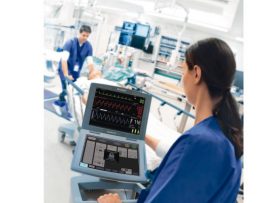The Coronavirus Disease 2019 (COVID-19) pandemic has required rapid and effective protocol adjustments at every level of healthcare. The use of extracorporeal membrane oxygenation (ECMO) is pivotal to COVID-19 treatment..
Read MoreAbstract The role of extracorporeal membrane oxygenation (ECMO) in the management of critically ill COVID-19 patients remains unclear. Our study aims to analyze the outcomes and risk factors from patients..
Read MoreSevere respiratory syndrome coronavirus-2 is responsible for coronavirus disease 2019 (COVID-19), which may lead to acute respiratory failure. In its most severe manifestation including refractory hypoxemia and/or hypercapnia, it can..
Read MoreObjective Cerebral autoregulation (CA) impairment may pose a risk factor for neurological complications among children supported by extracorporeal membrane oxygenation (ECMO). Our first objective was to investigate the feasibility of..
Read MoreMechanical ventilation (MV) is a crucial element in the management of acute respiratory distress syndrome (ARDS), because there is high level evidence that a low tidal volume of 6ml/kg (protective..
Read MoreCurrently, many centers use venovenous extracorporeal membrane oxygenation (VV-ECMO) as an adjunctive means of gas exchange to mechanical ventilation (MV) in patients with severe ARDS and refractory hypoxemia. One of..
Read MoreAbstract Rationale: Current practices regarding mechanical ventilation in patients treated with extracorporeal membrane oxygenation (ECMO) for acute respiratory distress syndrome are unknown. Objectives: To report current practices regarding mechanical ventilation in patients..
Read MorePurpose Extracorporeal membrane oxygenation (ECMO) is a rescue therapy for patients with acute respiratory distress syndrome (ARDS). The aim of this study was to evaluate associations between ventilatory settings during..
Read MoreVenovenous extracorporeal membrane oxygenation (vv-ECMO) has been classically employed as a rescue therapy for patients with respiratory failure not treatable with conventional mechanical ventilation alone. In recent years, however, the..
Read MoreAcute Respiratory Distress Syndrome (ARDS) is one of the most demanding conditions in an Intensive Care Unit (ICU). Management of analgesia and sedation in ARDS is particularly challenging. An expert..
Read MoreThe use of extracorporeal membrane oxygenation has had a positive impact on the outcomes after lung transplantation. Extracorporeal membrane oxygenation has a role in all phases of lung transplantation—preoperative, intraoperative,..
Read MoreSevere cases of coronavirus disease 2019 (COVID-19) cannot be adequately managed with mechanical ventilation alone. The role and outcome of extracorporeal membrane oxygenation (ECMO) in the management of COVID-19 is..
Read MoreBACKGROUND: No consensus exists on the optimal settings of mechanical ventilation during veno-venous extracorporeal membrane oxygenation (ECMO). Our aim was to describe how mechanical ventilation and related interventions are managed..
Read MoreBackground The efficacy of extracorporeal membrane oxygenation (ECMO) in bridging children with unrepaired heart defects to a definitive or palliative surgical procedure has been rarely reported. The goal of this..
Read MoreBackground Postcardiotomy cardiogenic shock (PCCS) refractory to inotropic support and intra-aortic balloon pump (IABP) occurs rarely but is almost universally fatal without mechanical circulatory support. In this systematic review and..
Read MoreBackground Post-cardiotomy cardiogenic shock (PCCS) has an incidence of 2–6 % after routine adult cardiac surgery. 0.5–1.5 % are refractory to inotropic and intra-aortic balloon pump (IABP) support. Advanced mechanical circulatory support..
Read MoreBackground Venoarterial extracorporeal membrane oxygenation (V-A ECMO) improves perfusion and oxygenation in patients with cardiogenic shock. However, it can also result in supranormal oxygen exposure. Recent evidence suggests hyperoxia may..
Read MoreAbstract Extracorporeal membrane oxygenation (ECMO) refers to specific mechanical devices used to temporarily support the failing heart and/or lung. Technological advances as well as growing collective knowledge and experience have..
Read MoreVenoarterial extracorporeal membrane oxygenation has emerged as a viable treatment for patients in cardiogenic shock with biventricular failure and pulmonary dysfunction. Advances in pump and oxygenator technology, cannulation strategies, patient selection and management, and durable mechanical circulatory support have..
Read MoreThe use of veno-arterial extracorporeal membrane oxygenation (VA-ECMO) as a salvage therapy in cardiogenic shock is becoming of current practice. While VA-ECMO is potentially a life-saving technique, results are sometimes mitigated, emphasising the need for selecting..
Read MoreBackground There is a lack of consensus on how to manage anticoagulation during veno-venous extracorporeal membrane oxygenation, including antithrombin monitoring and supplementation. The authors’ aim was to determine current practice..
Read MoreCardiosave es un dispositivo de vanguardia que proporciona una terapia de contrapulsación intraaórtica fiable y absolutamente probada. Getinge diseñó Cardiosave para aportar mayor flexibilidad de uso tanto en configuración hospitalaria..
Read MoreIntroduction Lactic acidosis after cardiac surgery with cardiopulmonary bypass is common and associated with an increase in postoperative morbidity and mortality. A number of potential causes for an elevated lactate..
Read MoreAbstract Objective Preoperative anemia management reduces red blood cell (RBC) transfusion and adverse outcomes, but how best to optimize the patient’s hemoglobin (Hgb) before cardiac surgery remains unclear. The authors..
Read MoreAbstract Background Bloodstream infection (BSI) is an important complication of extracorporeal membranous oxygenation (ECMO) and a major cause of mortality. This study evaluated the epidemiological and clinical characteristics of BSI..
Read MoreAbstract Background Recent military and civilian experience suggests that fresh whole blood may be the preferred for treatment of hemorrhagic shock, but its use is limited by its 21-day shelf life. The red..
Read MoreAbstract The new coronavirus infection, which was first seen in China in late December, 2019 and eventually became a worldwide pandemic, poses a serious threat to public health. After a..
Read MoreAbstract Introduction Anemia and blood transfusion are risk factors for morbidity/mortality in patients undergoing cardiac surgery with cardiopulmonary bypass (CPB). The objective of this study is to analyze the association..
Read MoreAbstract Background We designed a prospective randomized clinical study to compare unilateral and bilateral antegrade cerebral perfusion (ACP) under moderate hypethermia in open distal aortic hemiarch replacement in ascending aortic..
Read MoreAbstract Objectives Neurodevelopmental injury after cardiac surgery using cardiopulmonary bypass (CPB) for congenital heart defects is common, but the mechanism behind this injury is unclear. This study examines the impact..
Read More














